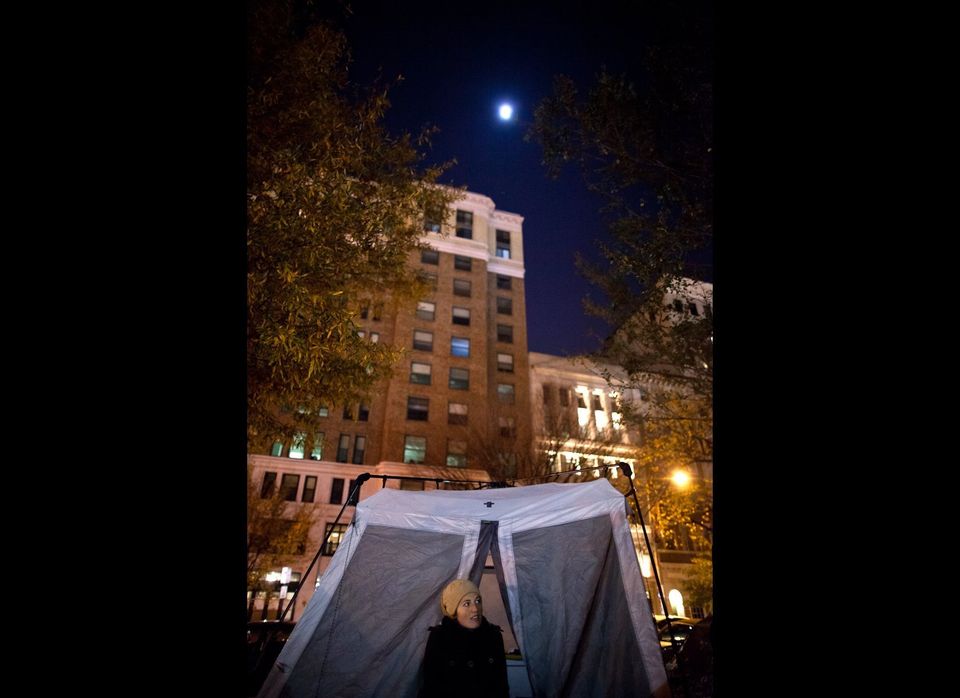Many of the tents have been cleared, the sidewalks cleaned, and the statue of General McPherson extricated from the enormous blue tarp known as the "Tent of Dreams." By visible accounts, Occupy D.C. is waning, and life in the nation's capital is starting to return to normal.
Except, of course, for the people who used to live in the McPherson Square and Freedom Plaza tent communities. Late the night after police began enforcing no-camping regulations, several protesters clustered around a hostel kitchen table at Washington, D.C.'s Luther Place Memorial Church. One rested his head in his hands; another stared blankly, seeming unsure of what to do next.
Meanwhile, members of the organization known as Occupy Faith D.C. scurried about, coordinating with local churches and brainstorming about the best way to feed and shelter the displaced. For this interfaith coalition that supports the Occupy movement, the questions are swirling: Where will the protesters stay? Who will provide food? Who is available to spend tonight at Luther Place, to make sure that things remain peaceful?
Much of the criticism directed at the Occupy Movement has focused on protesters' lack of clear objectives. However, as I've witnessed while photographing religious groups involved in the protest, for many people of faith in D.C., these goals are as bright as day: social and economic justice, and equal support for all human beings, regardless of circumstance.
As a photojournalist specializing in coverage of religious issues, I never imagined I'd end up documenting Occupy D.C., which, to me, initially seemed to be just another political protest in the nation's capital, and a largely secular one, at that. Along with other residents of the District, I quickly came to associate Occupy with urban campsites, traffic-snarling marches through the streets, and vague goals of government overhaul.
Yet, after spending ample time among protesters and activists, I've realized that one of the biggest stories of the Occupy D.C. protest isn't the physical occupation, but the further displacement and need it has generated, something that has truly galvanized the city's religious community, among others. I have spent the past three and a half months working on a photography project about this largely unseen spiritual side of the movement.
For me, photojournalism is about generating new understanding. I photograph religion not because I come from a strong religious background, nor because I want to promote a certain faith. Rather, I hope to share the human stories behind doctrines, and to shed new light on a topic that tends to be frustratingly opaque and generalized.
There are plenty of pictures out there that depict religion in practice, suggesting that it is something confined mostly to the church, mosque, temple, or synagogue. I'm most interested in showing what happens outside of worship -- in showing how faith is lived, and the societal circumstances that shape it. In the time I've spent documenting Occupy, I have gotten to photograph faith in action, and as a response to social crisis.
Initially, I hoped to focus on religion's presence in the downtown campsites -- for instance, McPherson Square's Christian prayer tent, denoted by a cross hand-drawn in Sharpie on the tent's exterior; also, the Muslim prayer services said to be held in the park on Friday afternoons. Gradually, however, I became more interested in showing how people of faith are embracing the ideals of the Occupy movement.
A Christian activist organization known as Occupy Church was one of the first Occupy religious groups I encountered. Now led in part by Jeremy John, Micah Bales, and Shannon Berry, Occupy Church began by hosting regular Saturday services in the iconic prayer tent, inviting protesters inside for worship and discussion. The organizers also staffed the tent at night, offering tea and conversation to passers-by. Occupy Church served as a peacekeeping force in the thriving community, and as a source of spiritual sustenance for some.
But as the physical occupation matured and in some ways degenerated, so did the prayer tent: People stole from it, vomited inside, and used it as a place to have sex. Though Occupy Church has continued to stand in solidarity with D.C.'s remaining Occupiers, I have photographed its transformation into a separate ecumenical movement, one that now meets offsite to strategize how to revive social justice practices in today's Christian community.
I've documented a slightly different form of activism in Occupy Faith D.C., the overarching coalition with which Occupy Church affiliates. The organization has brought together people of diverse religious backgrounds in support of the protesters' cause. Rather than focusing on reform within a specific tradition, clergy, rabbis, and members from other faiths have provided on-the-ground assistance to Occupiers, including teach-ins and meals at the D.C. camps and around the city. Championing the phrase "Enough for Everyone," Occupy Faith recently hosted a public meal known as the "People's Prayer Breakfast," meant to rival the National Prayer Breakfast being held nearby. It hosted a similar feast in November for the Thanksgiving holiday.
The group's actions have been especially visible during the decline of the downtown D.C. encampments. As my inbox fills with listserv e-mails coordinating food donations, temporary shelters, and transportation for the dozens of newly displaced protesters, part of me wonders how exhausting efforts like these can be possibly be sustainable.
Yet, as I continue to photograph devoted volunteers at shelters around the city, I sense that I am finally encountering and sharing a concrete example of what Occupy stands for.
Below, a slideshow of photos from Occupy events
